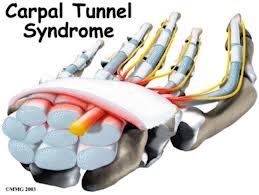BASICS
- Peripheral neuropathy conditions such as Carpal Tunnel Syndrome are increasing.
- Central neuropathy conditions such as Multiple Sclerosis are increasing.
- Dementia is increasing.
- Obesity and Adolescent Obesity increase the risk.
IDEAS
Vessel and Tissue Inflammation
A combination of ischaemia (decreasing blood supply), compression and inflammation occurs in a peripheral nerve.
As a result of this combination there is a microvascular intraneural occlusion which effectively interrupts the normal transport of nutrients up and down a nerve fibre. Given enough time, and with associated inflammation, the nerves themselves become scarred and lose their protective fat layer. That results in an ongoing progressive deterioration of function and symptoms.
The model of fructose and polyunsaturated oils combining to give us the subintimal inflammation in every blood vessel promotes this concept. It creates the susceptibility to damage from even mild compression.
The reversal of our dietary intake has the potential to improve some symptoms. Anecdotally I have some patients now who have in fact done this with an improvement in their neurological type symptoms.
There is nothing to lose from reducing the sugar and processed food intake in the diet for a few months and seeing what happens.
Painful Conditions
Cutting down on sugar seems to be helpful for some patients with a variety of painful conditions including those related to nerve compression, period pain (dysmenorrhea) as well as chronic pain management. It costs nothing to cut down on fructose in the management of pain and you might very well be surprised by the benefits that occur.
Read about the Damage Process
Read about the Metabolism
Read about the other Health Issues
The NoFructose Handout Starter Sheet is your take away summary of this web site. Read it at the NoFructose Starter Sheet area of this web site or download it.
MORE INFORMATION
Peripheral Neuropathy
Peripheral neuropathy such as carpal tunnel syndrome, ulnar neuritis and possibly even sciatica are increasing as far as we can ascertain. There has certainly been an increase in multiple sclerosis and neuropathic conditions as a whole.
It is my belief that there is a combination of ischaemia (decreasing blood supply), compression and inflammation that occurs in a peripheral nerve. As a result of this combination there is a microvascular intraneural occlusion which effectively interrupts the normal transport of nutrients up and down a nerve fibre. Given enough time, and with an associated inflammation, the nerves themselves become scarred and lose their protective fat layer. That results in an ongoing progressive deterioration of function and symptoms.
The model of fructose and polyunsaturated oils combining to give us the subintimal inflammation in every blood vessel promotes this concept.
Again, a reversal of our dietary intake has the potential to improve some symptoms and anecdotally I have some patients now who have in fact done this with an improvement in their neurological type symptoms. There is nothing to lose from reducing the sugar and processed food intake in the diet for a few months and seeing what happens.
In 2012 I studied the uric acid levels of 40 patients who had carpal tunnel syndrome decompression. 26 percent of these patients had an elevated uric acid level and were previously undiagnosed with gout.
When one looks at the production of uric acid it is a by-product of fructose metabolism and it may be that uric acid is an indirect measure of fructose consumption over time. It may be a useful investigation in the investigation of neurological symptoms.
The NoFructose Handout Starter Sheet is your take away summary of this web site. Read it at the NoFructose Starter Sheet area of this web site or download it.
Please add information by going to Contribute to NoFructose.com
ARTICLES
The ketogenic diet as a treatment paradigm for diverse neurological disorders.
Dietary and metabolic therapies have been attempted in a wide variety of neurological diseases, including epilepsy, headache, neurotrauma, Alzheimer disease, Parkinson disease, sleep disorders, brain cancer, autism, pain, and multiple sclerosis. The impetus for using various diets to treat – or at least ameliorate symptoms of – these disorders stems from both a lack of effectiveness of pharmacological therapies, and also the intrinsic appeal of implementing a more “natural” treatment. The enormous spectrum of pathophysiological mechanisms underlying the aforementioned diseases would suggest a degree of complexity that cannot be impacted universally by any single dietary treatment. Yet, it is conceivable that alterations in certain dietary constituents could affect the course and impact the outcome of these brain disorders. Further, it is possible that a final common neurometabolic pathway might be influenced by a variety of dietary interventions. The most notable example of a dietary treatment with proven efficacy against a neurological condition is the high-fat, low-carbohydrate ketogenic diet (KD) used in patients with medically intractable epilepsy. While the mechanisms through which the KD works remain unclear, there is now compelling evidence that its efficacy is likely related to the normalization of aberrant energy metabolism. The concept that many neurological conditions are linked pathophysiologically to energy dysregulation could well provide a common research and experimental therapeutics platform, from which the course of several neurological diseases could be favorably influenced by dietary means. Here we provide an overview of studies using the KD in a wide panoply of neurologic disorders in which neuroprotection is an essential component.
